Talent Monitor: Rate development professionals 2024
Rate development professionals 2024
We are balancing between economic contraction and growth. After nine months of decline, we saw a modest rebound in our economy in the fourth quarter of 2023. Despite once again challenging market conditions such as inflation and "higher" market interest rates, we ventured another forecast for 2024 with this Talent Monitor. You can read about it in this report.
Hourly rates for self-employed and seconded workers lag behind collective bargaining wages
The hourly rates of flexible workers, self-employed workers and professionals employed by secondment agencies, rose an average of 4.3 percent in 2023 compared to 2022. This increase lags slightly behind the trend in collective bargaining wages. An average rate increase of one to two percent is expected for 2024. This is according to the latest Talent Monitor from labor market data specialist Intelligence Group and HR-tech service provider HeadFirst Group.
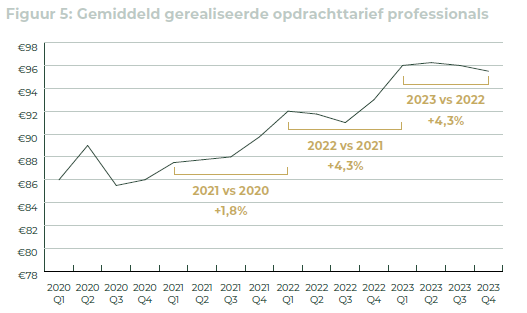
Key findings
- After three quarters of contraction in the Dutch economy, the fourth quarter of 2023 shows a slight increase of 0.3% compared to the third quarter. Compared to 2022, however, there is still a decline of 0.5%.
- Several signs indicate that there is some relief in the scarcity in the labor market. Demand for personnel is decreasing slightly and supply appears to be increasing slightly.
- Compared to a year ago, labor market activity among self-employed professionals - the extent to which they move from assignment to assignment - shows a slight increase from 20.1 to 21.7% in the fourth quarter of 2023, compared to the same quarter in 2022. There was also some growth in the group of latent professionals, who, while not actively seeking new assignments, are open to other options. At the same time, the number not moving at all decreased.
- There has been a sharp increase in the average number of offers per job. By the end of 2023, this number was almost at the same level as during the peak in the second quarter of 2020.
- The number of self-employed people who want to be employed (back) has increased slightly. At 11.6%, it is still far behind the percentage in 2021, when it was 17.0%. In addition, just 13.0% of employees indicate that they would like to work as a self-employed person (again).
- Sourcing pressure continues to grow unchanged: on average, self-employed individuals are approached about 18 times a year for a job. More than six in 10 are approached at least once a quarter.
- Data from HeadFirst Group shows that the rates of flexible workers - self-employed and professionals employed by secondment firms - who started a new assignment in 2023 rose an average of 4.3% compared to 2022.
Partner

Download Talent Monitor
By downloading the Talent Monitor, you agree that your data will be shared with co-initiator Intelligence Group.
Other reports...
Tightness in flex market past peak
The scarcity in the labor market - both for permanent and flexible...
Talent Monitor: The convergence of fixed and flex
We compile quarterly - based on recruitment data from...
Talent Monitor: Fixed is getting more mobile and flex is getting more sustainable
We compile quarterly - based on recruitment data from...
Talent Monitor: Rate development professionals 2023
We compile quarterly - based on recruitment data from...
Talent Monitor: update forecast rate development professionals 2022
We compile quarterly - based on recruitment data from...
Talent Monitor: Zzp'ers: protect or set free?
We compile quarterly - based on recruitment data from...
HeadFirst Group responds to the internet consultation on the Law on Admission for the Posting of Workers
HeadFirst Group responds to the internet consultation on the Law on Admission for the Posting of Workers
From Wednesday, January 24 through Saturday, February 24, it was possible to respond to the Internet consultation on the amendment of the Decree on allocation of labor forces by intermediaries. This in connection with the plans to introduce an admission system. A total of sixteen public responses were submitted.
As a market-leading organization, we believe it is important to contribute to the political-social debate on the future of the (flexible) labor market. For this reason, we also responded to the internet consultation. Below is a brief summary of our response point by point:
- HeadFirst Group is concerned about the broad scope of the admission system. We embrace the recommendations of the Roemer Commission to improve the position of migrant workers, but as an HR service provider at the top of the market, we have nothing to do with this issue. We therefore call for more customization;
- Much important information in the Explanatory Memorandum is currently missing. The draft decision does not yet contain a framework of standards and information is also missing with regard to the waiver scheme. In order to make a well-considered and complete judgment on this change, it is important that we as an organization have all relevant figures and obligations;
- HeadFirst Group supports the advice of the Advisory Panel on Regulatory Burden (ATR) to investigate less burdensome alternatives and first firmly enforce the laws and obligations in force. By following this advice, companies will be prevented from being saddled with at least 143 million euros of additional regulatory burden every year;
- The broad scope means that thousands of companies will soon have to be admitted to the system. This requires good representation from industry associations and umbrella organizations so that all interests and concerns are heard in a timely and regular manner.
Curious about our full input? Check out our response here.
Tightness in flex market past peak
Rate increase for self-employed and seconded workers lags behind inflation
The scarcity in the labor market - both for permanent and flexible staff - has been severe for years, but in the flex market it seems to have passed its peak. The number of responses from professionals to assignments is rising and the number of assignments without bids is falling. Hourly rates are also rising, but lagging behind inflation with an average increase of 3.7 percent. This is according to the latest Talent Monitor from labor market data specialist Intelligence Group and HR-tech service provider HeadFirst Group.
Increase in flex supply finally squeezes scarcity
The total number of highly skilled self-employed workers has increased by 325,000 since 2018 (+30 percent). In that time, over a hundred thousand seconded workers have also joined the workforce, which together represents a sharp increase in the supply of "flex. From 2020 to 2022, this did not result in less scarcity because demand was enormous. Since this year, that has changed.
Labor market activity, the figure that tells how actively people offer themselves in the labor market, has been rising since the summer of 2022 and even faster since the beginning of 2023. This is reflected in the number of offers per job: it has returned to pre-corona crisis levels. The number of assignments without offers has fallen sharply to below 10 percent.
Geert-Jan Waasdorp, CEO Intelligence Group, explains, "The tightness in the flex market is easing but remains as great as ever. Although the first professional groups are now noticing this turn, the current market is still a huge opportunity for employees to make the step to self-employment - with decent income security. For many organizations, flexible employment remains a solution to the tightness in the permanent labor market."
Rate increase lags behind inflation
Rates for highly skilled self-employed and seconded workers continue to rise, up 3.7 percent from the first half of 2022. This falls far short of the rise in inflation. This is another indication that the labor market is becoming less tight.
Rates for junior professionals rose relatively sharply in percentage terms, by 8.3 percent. Motivated, on the one hand, by starting salaries that are rising broadly and, on the other, by the fact that these rates - because they are lower - can rise percentage-wise faster. Marion van Happen, CEO at HeadFirst Group, finds this a striking development: "The trend is precisely that there is proportionately more demand for professionals with experience. Due in part to AI innovations and the flattening of the economy - not to mention the challenges with Generation Z workers - clients prefer mediors and seniors."
More insights into developments in the permanent and flexible labor market? Download the latest Talent Monitor here.
Talent Monitor: The convergence of fixed and flex
The convergence of fixed and flex
In this edition, we take the unique step of comparing rates for permanent and flexible staff, by target group. Which hired professionals are much more expensive than their permanent colleagues? And which ones, on the contrary, are not? An important development towards a full-fledged data model for Total Talent Management.
Tightness in flex market past peak
The scarcity in the labor market - for both permanent and flexible staff - has been severe for years, but in the flex market it seems to have passed its peak. The number of responses from professionals to assignments is rising and the number of assignments without bids is falling. Hourly rates are rising, but lag behind inflation with an average increase of 3.7 percent.
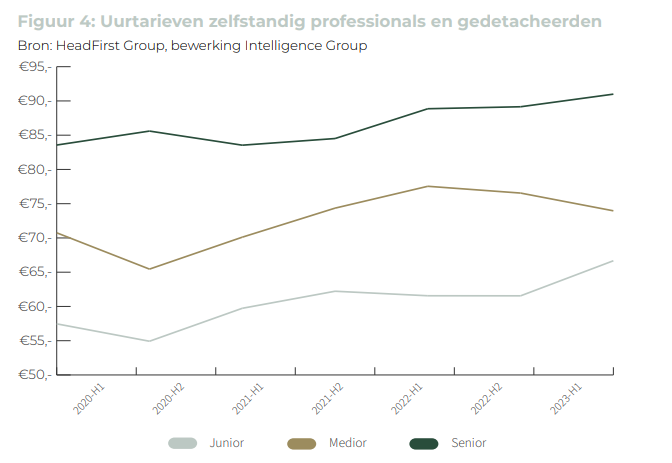
Key findings
- The worst of the tightness seems to be over in the market for highly skilled independent professionals and secondees. The number of offers on assignments is rising and is almost at the level before the corona crisis. The number of assignments without offers is decreasing and moving below 10%. At the same time, we see that labor market activity and sourcing pressure are picking up. All characteristics that "supply" is stirring and is available or coming.
- The number of highly educated independent professionals has increased by nearly 30% in the last five years. This is an explosive increase of about 325,000 people. In addition, over a hundred thousand seconded workers have been added during the same period.
- In the first half of 2023, the rates of highly skilled self-employed professionals and secondment agencies increased by an average of 3.7% compared to the same period in 2022. With this, rates do not follow inflation, self-employed workers lose purchasing power and secondment agencies lose their margin.
- Junior professionals, a group predominantly provided by secondment agencies, became 8.3% more expensive. They are better able to pass on inflation to clients for these juniors, among other things. While clients are actually favoring medior and senior professionals more, due in part to AI innovations, the flattening of the economy and the challenges with Generation Z workers. Nevertheless, in the first part of 2023, mediors took off a "jacket" in terms of rates. This appears to be an offsetting effect from 2022, when an increase of more than 10% was seen. Over two years, this averages out.
- Flexible work has the image of being "expensive. But how much more expensive is flex really? Between the hiring rate and fixed salary (including vacation pay, social and employer expenses) is an average factor between 2.4 and 2.7. As the level of experience increases, the factor increases. In certain very scarce professional groups, such as gardeners or caregivers IG, the factor climbs to almost 4. For psychologists, policy officials and professional groups - where procurement is mostly through SLAs and tenders - the factor is lower to just near or below 2.
Partner

Download Talent Monitor
By downloading the Talent Monitor, you agree that your data will be shared with co-initiator Intelligence Group.
"*" indicates required fields
Other reports...
Tightness in flex market past peak
The scarcity in the labor market - both for permanent and flexible...
Talent Monitor: The convergence of fixed and flex
We compile quarterly - based on recruitment data from...
Talent Monitor: Fixed is getting more mobile and flex is getting more sustainable
We compile quarterly - based on recruitment data from...
Talent Monitor: Rate development professionals 2023
We compile quarterly - based on recruitment data from...
Talent Monitor: update forecast rate development professionals 2022
We compile quarterly - based on recruitment data from...
Talent Monitor: Zzp'ers: protect or set free?
We compile quarterly - based on recruitment data from...
Talent Monitor: Fixed is getting more mobile and flex is getting more sustainable
Fixed is becoming more mobile and flex more sustainable
In this Talent Monitor, we took a closer look at the duration of jobs and assignments of workers. In doing so, we explicitly looked for the overlap and correlation between permanent and flex in the inflow and labor market activity and zoom in on retention and retention.
Staff retention is the new recruiting
Labor market activity - which involves actively looking for a job/assignment yourself - is historically low for both permanent and flex workers. In contrast, external mobility is at a record high, which for salaried workers means they are almost twice as likely to change employers as in 2015. This is almost twice the rate of internal mobility. Employers are hardly betting on internal careers and advancement opportunities, instead focusing primarily on recruitment in the external labor market. This is a major driver of costs and the loss of productivity and job happiness.
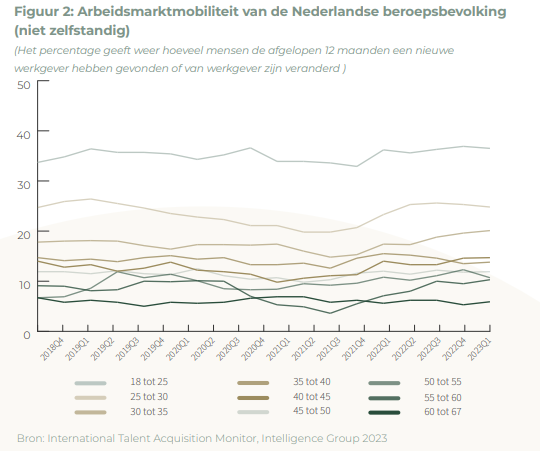
Key findings
- Labor market activity (actively looking for a job/assignment yourself) is historically low for both permanent and flex, prompted by the tightness in the labor market. This puts more emphasis on sourcing and active mediation by intermediaries and secondments.
- In contrast, external mobility is at a record high, which for salaried workers means that they are changing employers almost twice as fast as in 2015. In early 2023, the duration of a salaried job for the entire Dutch labor force will be less than five years, down from eight years in 2015.
- It is almost twice as large as internal mobility. Which means, concretely, that employers are hardly betting on internal careers and advancement opportunities, but are concentrating mainly on recruitment in the external labor market. This is a major driver of costs and the loss of productivity and job happiness.
- Whereas employees are employed for shorter and shorter periods, the initial assignment duration of contractors - independent professionals and secondees - is steadily increasing to an average of 205 days. In the process, the percentage of assignments that are renewed after the initial assignment is also increasing again, to 61% in 2022.
- Not paying or charging a market-based labor market rate according to professional group and level of experience lowers the likelihood of renewing an assignment, both from the client and contractor's perspective. It also increases the need for greater transparency and increases the call for independent data-driven rate information.
- The probability of being renewed and the duration of the contract - in addition to the rate - also depends on type of position (embedding), type of project (head-to-head), initial duration (the longer, the lower the probability of being renewed) and the industry (tendered/not tendered).
Partner

Download Talent Monitor
By downloading the Talent Monitor, you agree that your data will be shared with co-initiator Intelligence Group.
Other reports...
Tightness in flex market past peak
The scarcity in the labor market - both for permanent and flexible...
Talent Monitor: The convergence of fixed and flex
We compile quarterly - based on recruitment data from...
Talent Monitor: Fixed is getting more mobile and flex is getting more sustainable
We compile quarterly - based on recruitment data from...
Talent Monitor: Rate development professionals 2023
We compile quarterly - based on recruitment data from...
Talent Monitor: update forecast rate development professionals 2022
We compile quarterly - based on recruitment data from...
Talent Monitor: Zzp'ers: protect or set free?
We compile quarterly - based on recruitment data from...
Talent Monitor: Rate development professionals 2023
Rate development professionals 2023
In this edition of the Talent Monitor, we look back at developments in 2022 and express expectations for 2023.
Rate hike of four to six percent for self-employed and seconded workers in 2023
The hourly rates of flexible workers, self-employed and professionals employed by secondment agencies, rose an average of 3.8 percent in 2022. This is a lot less hard than predicted, under pressure from scarcity and inflation. This emerges from analysis by labor market data specialist Intelligence Group and HR-tech service provider HeadFirst Group. In 2023, they expect an average rate increase of four to six percent.

Key findings
- In the past year, 127,000 new zzp'ers entered the market. This makes them the fastest growing group of workers in the Dutch labor market, now accounting for over 10% of the Dutch labor force.
- Figures from Intelligence Group show that only 10.5% of highly educated self-employed people want to return to paid employment. In early 2021, this was still 17%.
- In 2023, the supply of professionals increases, in part because of the huge growth of highly skilled self-employed (independent professionals). Although the supply of active job seekers is still particularly low, the number of offers on assignments is expected to increase slightly, and the banks of secondments in early 2023 - in professional groups such as IT and marketing - will be slightly more filled than a year ago.
- Data from HeadFirst Group shows that the rates of professionals who started a new assignment in 2022 increased by an average of 3.8% compared to 2021. If extended agreements are also included in the average rate, the average rate increase is a small percentage point lower at 3.1%. This decrease is because renewals tend to go at the same rate, while new contracts go at a higher rate.
- The highest rate increase was seen in the first quarter of the year. In subsequent quarters, the increase was less, while scarcity and inflation continued to increase.
- If we assume the expected increase in collective bargaining agreements in 2023, the hourly rates of independent professionals will rise on average between 4 and 6% in 2023. The agreed wage increases for permanent staff and rate increases for independent professionals will not differ much from each other.
- Hourly rates follow and keep pace with collective bargaining developments. The annual average for 2022 now stands at 3.6%, although wage agreements accelerated to 6.4% in November 2022.
- Detachers will, if contracts and SLAs allow, raise rates slightly more to reflect current inflation.
- Clients do not take rigorous steps to widely index rates of professionals on current assignments. They take a performance-based approach: professionals whose rates are in line with performance are not indexed much, if at all, in the interim. Professionals with good performance and an hourly rate below the market average do get indexed - or at least sooner.
Partner

Download Talent Monitor
By downloading the Talent Monitor, you agree that your data will be shared with co-initiator Intelligence Group.
Other reports...
Tightness in flex market past peak
The scarcity in the labor market - both for permanent and flexible...
Talent Monitor: The convergence of fixed and flex
We compile quarterly - based on recruitment data from...
Talent Monitor: Fixed is getting more mobile and flex is getting more sustainable
We compile quarterly - based on recruitment data from...
Talent Monitor: Rate development professionals 2023
We compile quarterly - based on recruitment data from...
Talent Monitor: update forecast rate development professionals 2022
We compile quarterly - based on recruitment data from...
Talent Monitor: Zzp'ers: protect or set free?
We compile quarterly - based on recruitment data from...
Talent Monitor: IT labor market in figures
Talent Monitor: IT labor market in figures
The labor shortage in the Netherlands is now present in all occupational groups, according to the UWV. Figures for the second quarter of 2022 show that with a tension indicator - number of open vacancies divided by the number of people receiving unemployment benefits for less than six months - the occupational group IT is classified as the most tight of sixteen groups. Therefore extremely interesting to further scrutinize in this Talent Monitor.
By 2030: 1 in 10 in Dutch labor market IT professional
Currently, one in seventeen people in the Dutch labor market is an IT professional. In ten years, this has nearly doubled. At the current growth rate of almost seven percent per year, by 2030 one in ten of the Dutch labor force will be an IT professional. That said, the battle for salaried and temporary IT professionals, self-employed and employed by secondment companies, is in full swing. At nearly 65%, the sourcing pressure is unprecedentedly high, especially given the 37.6% average for the entire labor force.

Key findings
- No surprise: IT workers are extremely scarce. Demand is increasing, but supply is also rising 6.9% year on year. In the past decade, the number of IT workers has almost doubled, and by 2030 there will be over 1 million of them in the Netherlands. By then, one in ten people in the labor market will be IT professionals.
- There remains a continued growing demand for IT professionals, both employed and self-employed. The latter group is growing more slowly and is more dependent on cyclical fluctuations.
- There is increasing competition among clients who more often use labor market communications to be attractive, resulting in some having offers and others having none. The latter can certainly be called a trend. The tightness in the self-employed market means that clients are investing more in "selling" their assignments.
- The number of active job seekers is very low. The battle for the latent job and assignment seeker takes place primarily on LinkedIn, networks, platforms and the company's own VMS/ATS systems. While salaried IT professionals are increasingly being hounded - nearly two in three are approached at least once a quarter - it is notable that active sourcing of IT professionals seems to be on its way out slightly. This may run parallel to slightly fewer assignments on the market, and we don't want to call it a trend either, since it is by far the most important sourcing channel, of both permanent and flex.
- One in five IT professionals manages to remain structurally under the radar. This is quite apart from the group that is found and approached but does not respond. The right to privacy and the right to be unreachable is certainly a trend - whether or not soon supported by legislation in the Netherlands - that IT professionals are leading the way in the job market.
- In terms of working conditions and pull factors, IT professionals have already seen many of their needs met. That is increasingly a hygiene factor. Selling the job, the assignment and the work, that's the emphasis. What am I going to do? With whom? For whom? And why? Three sentences won't get you there as an employer.
Partner

Download Talent Monitor
By downloading the Talent Monitor, you agree that your data will be shared with co-initiator Intelligence Group.
Other reports...
Tightness in flex market past peak
The scarcity in the labor market - both for permanent and flexible...
Talent Monitor: The convergence of fixed and flex
We compile quarterly - based on recruitment data from...
Talent Monitor: Fixed is getting more mobile and flex is getting more sustainable
We compile quarterly - based on recruitment data from...
Talent Monitor: Rate development professionals 2023
We compile quarterly - based on recruitment data from...
Talent Monitor: update forecast rate development professionals 2022
We compile quarterly - based on recruitment data from...
Talent Monitor: Zzp'ers: protect or set free?
We compile quarterly - based on recruitment data from...
Talent Monitor: update forecast rate development professionals 2022
Talent Monitor: update forecast rate development professionals 2022
In December 2021, Intelligence Group and HeadFirst Group took a major, unique step by forecasting the rate trends of temporary professionals for 2022. At the same time, we announced an interim update on the predictions made for the middle of this year. Now is the time to present these insights.
Accelerated rate hike averaging 10.3% for self-employed and secondees in 2022
Flexible workers, more specifically, self-employed workers and professionals employed by secondment agencies, have become more expensive by an average of 4.7% in the first six months of 2022. Over the whole of this year, 10.3% rate increase is expected, with inflation and scarcity being the driving forces. This is according to data and the rate forecasting model from labor market data specialist Intelligence Group and HR tech service provider HeadFirst Group. This exceeds the average agreed wage increase for permanent staff, which remained stuck at 3.1% for the first half of 2022. Read the entire press release here
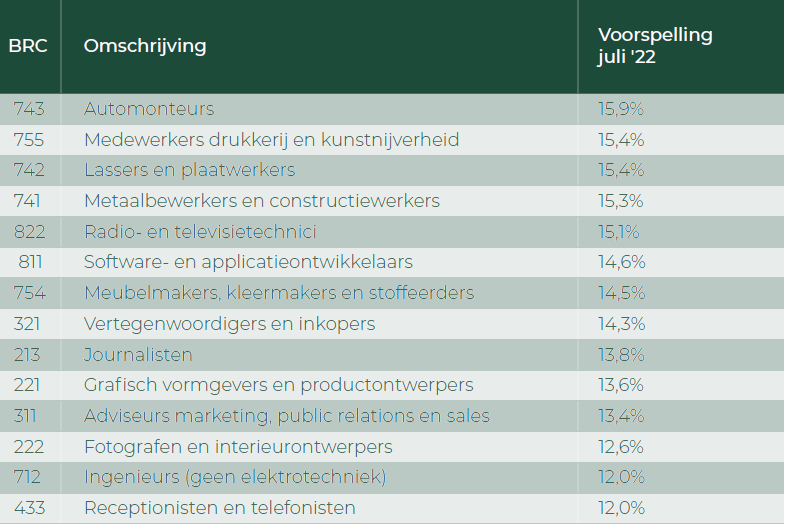
Inflation drives hourly rate up further
For this update, we analyzed the realized hourly rates of professionals - self-employed and professionals employed by secondment agencies - in the first half of 2022. Using this data, we were able to map out for 46 professional groups, within which the proportion of professionals is large, how the rate increase developed compared to the previously issued forecast for all of 2022. Motivated in part by an exceptionally scarce labor market and rocketing inflation, there are three main conclusions:
- The rate increase of professionals - practical and highly educated - averages 4.7% in the first six months of 2022.
- The hourly rate is expected to increase by an average of 10.3% by the end of the year. Still over 3% more (!) than already predicted in December 2021.
- The average agreed wage increase for permanent staff for the first half of 2022 is 3.1%. This leaves salaries behind current inflation, inflation expectations and average rate increases for professionals.
Partner

Download Talent Monitor
Other reports...
Tightness in flex market past peak
The scarcity in the labor market - both for permanent and flexible...
Talent Monitor: The convergence of fixed and flex
We compile quarterly - based on recruitment data from...
Talent Monitor: Fixed is getting more mobile and flex is getting more sustainable
We compile quarterly - based on recruitment data from...
Talent Monitor: Rate development professionals 2023
We compile quarterly - based on recruitment data from...
Talent Monitor: update forecast rate development professionals 2022
We compile quarterly - based on recruitment data from...
Talent Monitor: Zzp'ers: protect or set free?
We compile quarterly - based on recruitment data from...
Talent Monitor: Zzp'ers: protect or set free?
Talent Monitor: Zzp'ers: protect or set free?
We believe that exploitation in the labor market must be countered with appropriate measures, while at the same time not ignoring the large group of self-employed people who consciously choose to do business in complete freedom and have control over their own work. With the insights in this report, we hope to make a new contribution to this.
Only tens of thousands of 1.2 million self-employed work for hourly rate below 20 euros
Zzp'ers working as store assistants, childcare workers, teaching assistants, waiters or bartenders work on average at the lowest hourly rates in the Netherlands. They also have a relatively low scarcity indication, which predicts that the prospect of rate increases is limited. On the other hand, relatively few self-employed workers are active in these occupational groups, compared to the total of nearly 1.2 million. These insights were published in the Talent Monitor by HR service provider HeadFirst Group and labor market data specialist Intelligence Group.
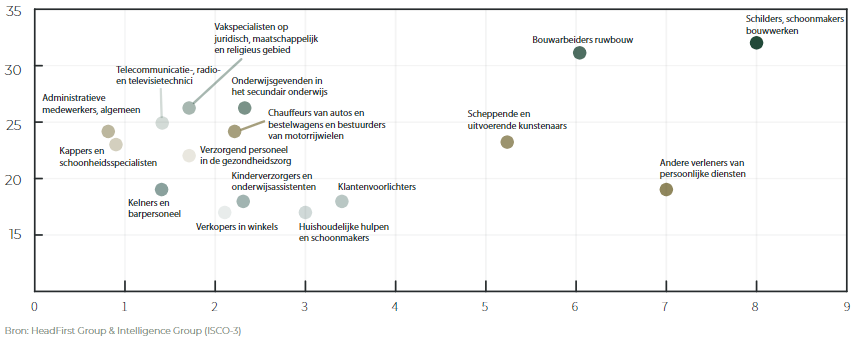
Main observations
- Self-employed people with an hourly rate of €35 or lower work mainly as domestic help and cleaners, waiters and bar staff or childcare and teaching assistants.
- In particular, the occupational groups of child care and teaching assistants and domestic helpers and cleaners seem to be the needy target groups based on the hourly rate and the prospect of rate increases.
- Specialists in the field of sports and fitness and authors, journalists and linguists can largely be found in the €36 to €70 rate group.
- Zzp'ers with an hourly rate of €70 or higher are overrepresented in professional groups such as lawyers, software and application developers and analysts, and doctors.
- At 28%, self-employed persons with an hourly rate of €35 or lower are slightly more actively looking for a (new) assignment than self-employed persons in the other two rate groups. The part that is not actively looking, but is keeping an eye on the market, at 49%, is actually smaller than the other two rate groups.
- Zzpp'ers with a lower hourly rate are more willing to go into paid employment (again) (18%). For self-employed people with an hourly rate of €70 or higher, that percentage is slightly lower, at 16%. For self-employed people with an hourly rate between €36 and €70, it stalls at 11%.
- Zzp'ers with an hourly rate of €70 or higher are approached most often by clients and intermediary agencies. Their sourcing pressure, the percentage who are approached at least once per quarter, is 67%. For freelancers with an hourly rate of €35 or lower, it is 63% and for freelancers with an intermediate hourly rate 61%.
- Zzpp'ers with an hourly rate of €35 or lower are less willing to travel far for an assignment. Half of the self-employed with an hourly rate of €70 or higher are willing to travel longer than an hour, compared with 37% of self-employed with an hourly rate of €35 or lower.
Partner

Download Talent Monitor
"*" indicates required fields
Previous editions
Tightness in flex market past peak
The scarcity in the labor market - both for permanent and flexible...
Talent Monitor: The convergence of fixed and flex
We compile quarterly - based on recruitment data from...
Talent Monitor: Fixed is getting more mobile and flex is getting more sustainable
We compile quarterly - based on recruitment data from...
Talent Monitor: Rate development professionals 2023
We compile quarterly - based on recruitment data from...
Talent Monitor: update forecast rate development professionals 2022
We compile quarterly - based on recruitment data from...
Talent Monitor: Zzp'ers: protect or set free?
We compile quarterly - based on recruitment data from...
Talent Monitor: Forecast tariff development professionals 2022
Talent Monitor: Forecast tariff development professionals 2022
Labor market data specialist Intelligence Group has developed a unique rate prediction model, which includes data from HeadFirst Group. At the end of 2021 we presented the first prediction, which has started an annual tradition.
On average, highly educated professionals will earn 5% more.
Self-employed persons without employees and agencies that second professionals will probably raise their fees considerably in 2022. On average, highly educated professionals will be able to raise their hourly rates by 5 percent in 2022. The highest increases are expected in vocational professions, with machine fitters expected to make the greatest wage jump - they will most likely earn 44.6% more. The average wage increase is expected to amount to 7 percent across the entire workforce, ranging from those with vocational training to those with higher education Read the entire press release here.
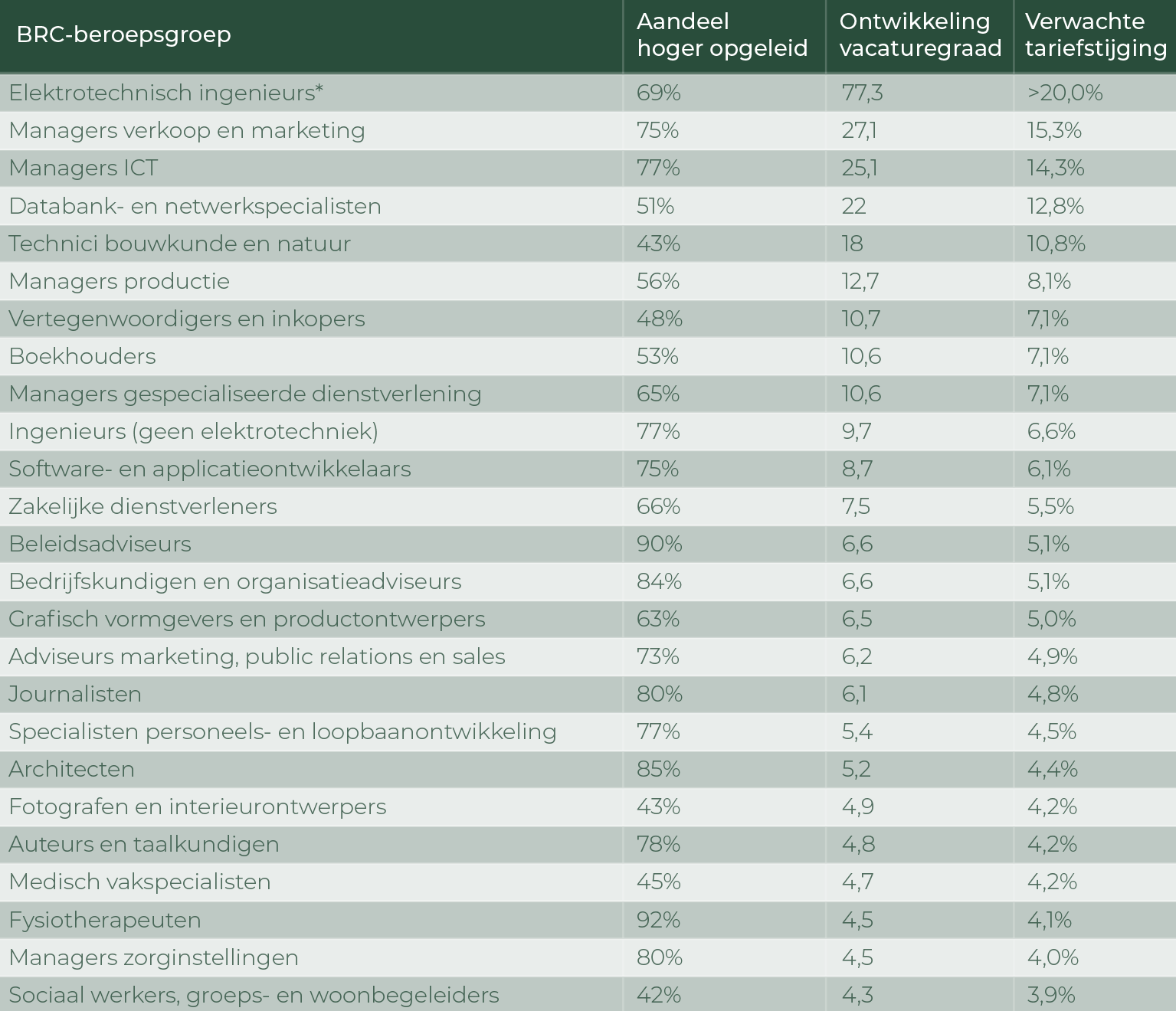
Key findings
- Fees are expected to rise by 7% on average in 2022. Fees charged by highly educated professionals are expected to rise by 5%, while fees charged by professionals working in more vocational and operational jobs (blue collar workers) are expected to rise by at least 7%.
- If we focus on the professionals' segment, we see that the only professionals for whom no fee increases are expected are logistics managers, librarians and curators. While the former do have a profession that is in demand, they are less in demand than last year. The greatest fee rises are expected for electrical engineers, sales and marketing managers, IT managers, database and network specialists, architects and engineering and forestry technicians.
- If we consider the more practical and operational segment, we see that only independent bus and streetcar drivers are expected to see their income reduced slightly (-1.1%). The greatest pay rises are expected for machine fitters, plumbers and pipe fitters, carpenters, electricians and electrical fitters, assembly workers, farmers and foresters, welders and platers and lorry drivers.
- Pay rises are mostly due to a constant, year-on-year increase of 1.8%. Such increases may largely seem to be due to inflation, but that is not always the reason. Increases or decreases in the number of outstanding vacancies in the profession also play a role. Fees fluctuate along with fluctuations in the number of outstanding vacancies, i.e. as the market becomes tighter or slacker. Together, these two factors explain the level of variance in the forecasting model for up to 90.6%.
Partner

Download Talent Monitor
"*" indicates required fields
Other reports...
Tightness in flex market past peak
The scarcity in the labor market - both for permanent and flexible...
Talent Monitor: The convergence of fixed and flex
We compile quarterly - based on recruitment data from...
Talent Monitor: Fixed is getting more mobile and flex is getting more sustainable
We compile quarterly - based on recruitment data from...
Talent Monitor: Rate development professionals 2023
We compile quarterly - based on recruitment data from...
Talent Monitor: update forecast rate development professionals 2022
We compile quarterly - based on recruitment data from...
Talent Monitor: Zzp'ers: protect or set free?
We compile quarterly - based on recruitment data from...

















